
There is nothing to remember us of what happened on the Oorsprongweg in Schoorl where the Schoorl concentration and internment camp was located during ww2 from February to November 1941. But for about 1.900 people, camp Schoorl was the first stage of a long agony to the Nazi camps elsewhere. More than 1.000 of them, mostly Jewish and political prisoners, have not returned. Whoever had passed this gate found himself behind barbed wire, prey to humiliation, abuse, stripped off their rights and at the mercy of the German occupier.
"For evil to flourish, it only requires good men to do nothing".
Simon Wiesenthal
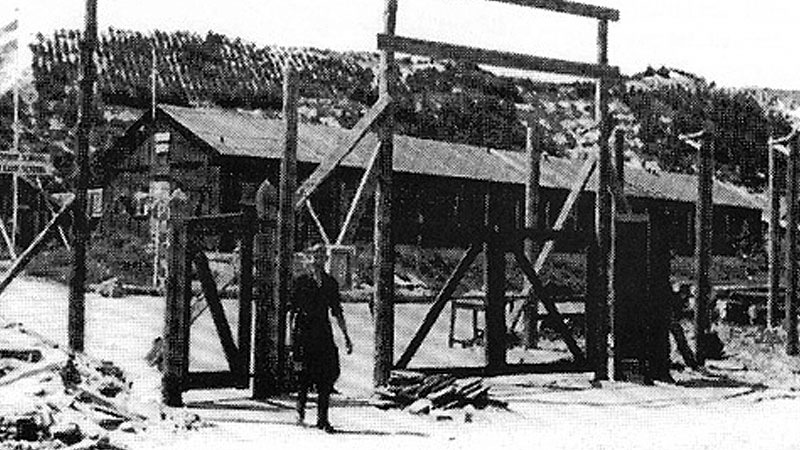
The main gate of Kamp Schoorl
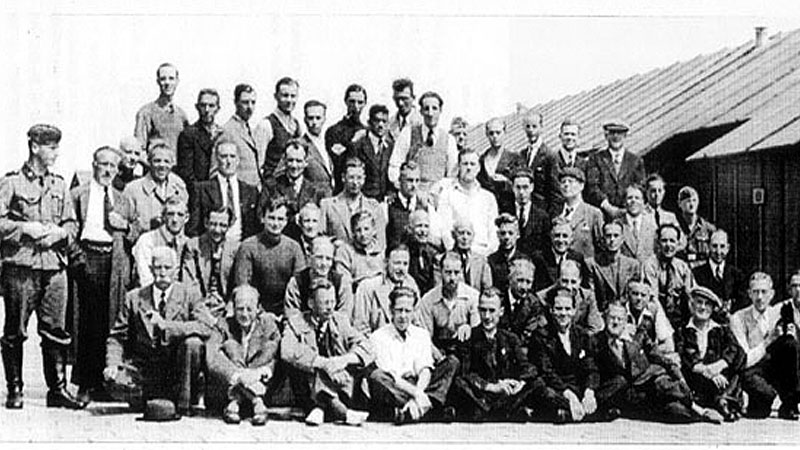
British detainees
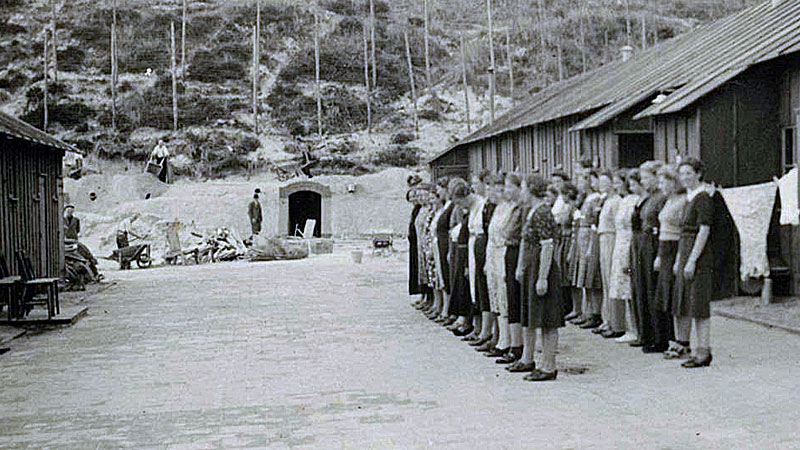
Female prisoners attending roll call
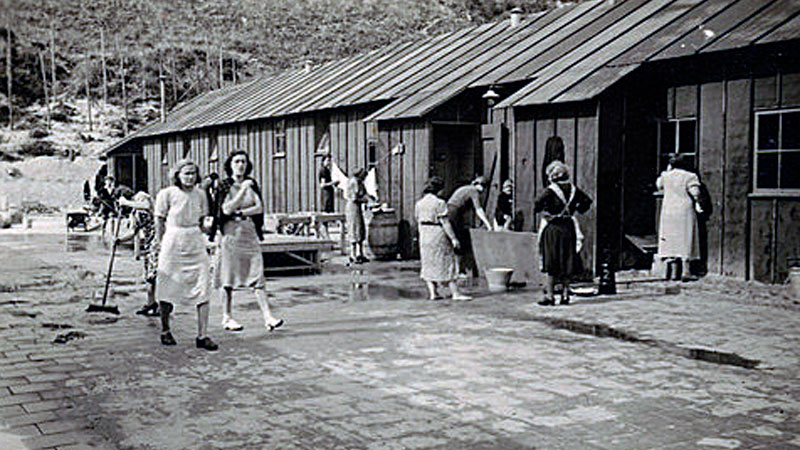
The female barracks
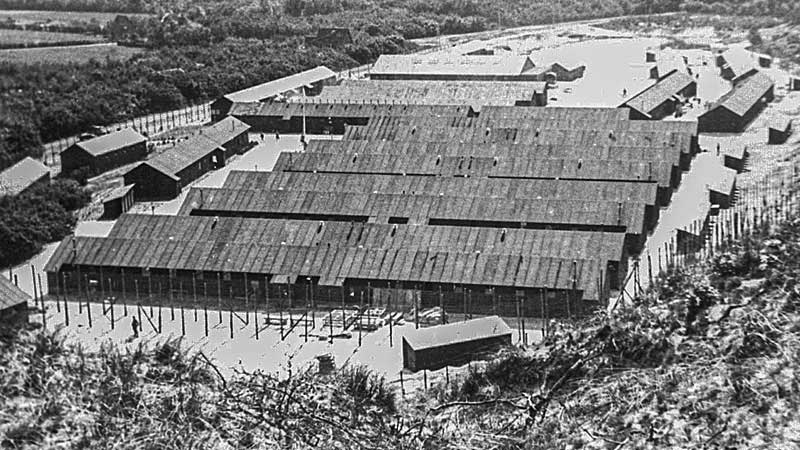
Overview of the camp grounds
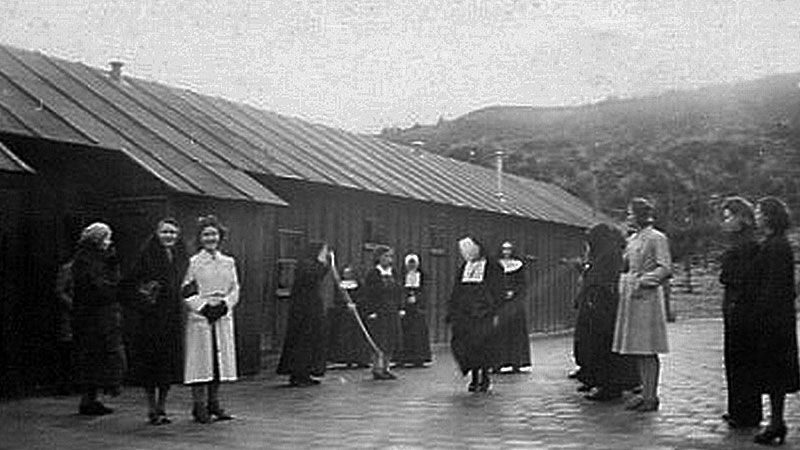
English Nuns in camp Schoorl
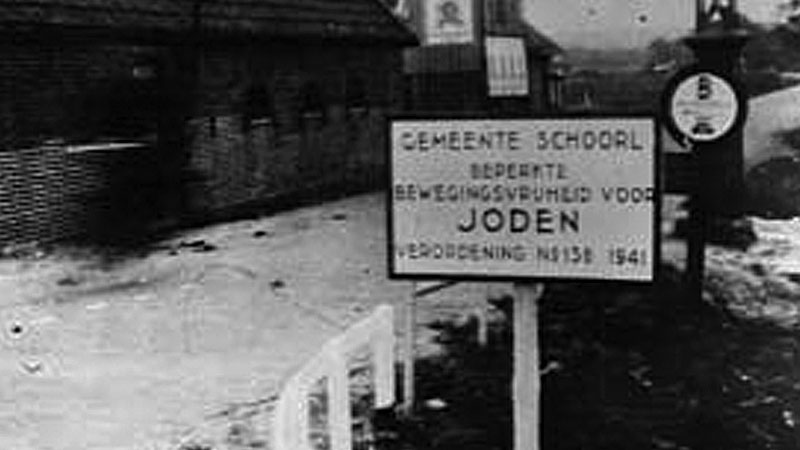
Sign for Jews
History, definition and facts about Kamp Schoorl
We now know that this small, relatively unknown camp, even if there were no deaths here and it functioned only briefly, was an indispensable and ominous link in the National Socialist policy aimed at the destruction of the Jews and Jewish life in Europe. and of those who resisted the German occupier. Keeping the memory of Camp Schoorl alive is therefore simultaneously keeping the memory of the Second World War alive. Kamp Schoorl admonishes us to be alert to the threat of war, to discrimination and anti-Semitism.
Kamp Schoorl was built by the Dutch army in the late summer of 1939, at the start of the general mobilization on August 28 and set up as an army camp on the site where the current ‘Buitencentrum’ of ‘Staatsbosbeheer’ is located. During construction, the soldiers were stationed in the nearby ‘Doopsgezind Broederschapshuis’, with the result that the approximately 60 Protestant Jewish-German refugees housed there suddenly had to be moved elsewhere on 25 August. Entered service on 25 November 1939.
Camp Schoorl was the first prisoner camp that the Germans set up in the Netherlands. It was closed in that capacity at the end of October 1941, probably because it was too small, too close to the coast and also too far from a railway
Camp Schoorl served as an army camp, an internment camp, a concentration camp and most recently after the war as a conference center. It’s history of use is the following.
Dutch army camp
From November 25, 1939 to May 1940, it housed six companies of reserve troops of the 21st Depot Battalion VIII Infantry. During the May days, the unit stationed in Schoorl did not take part in the combat actions.
German army camp
After the capitulation of the Netherlands on 15 May 1940, the camp was used for a month by a part of the Wehrmacht.
German Internment Camp
Citizens from countries which were at war with Germany, were interned in Schoorl in the course of June 1940: French and Belgian men, also English men and women. The boys under the age of eighteen were immediately released, so was a group of Alsatians who showed affection towards the Germans. The French and Belgians were released after about two months. On 3 September 1940, the British were transported to the civilian internment camp Ilag VIII in Tost (Toszek) in Poland. In December 1940, forty English women were interned; some of them were taken to Liebenau in February 1941, others to Vittel in the Vosges in France.
German Transitcamp
On February 23, 1941, the first group of prisoners, Jewish young men, arrived and the then empty camp was used as a concentration camp (Durchgangslager), until that function was transferred to Kamp Amersfoort on October 26, 1941. It is especially during this period that the name of the camp must join the others where the Germans acted criminally.
German Army Camp
Until the end of the war, units of the Wehrmacht and the Organization Todt were stationed in the camp, including the 787th Turkestan Infantry Battalion consisting of Turkmenian prisoners of war who had entered German military service, the so-called “Osttruppen”.
Dutch Detention Camp
After the liberation in 1945, the camp, as one of the 32 camps in North Holland, was used until the end of 1946 for the internment of SS, NSB, Youth Stormers and other collaborators. Among them many NSB mayors. In total there were about 2000 prisoners. The guards were mainly conscripted Dutch soldiers.
Dutch army camp
From the end of 1946 to September 1947, the camp served as an army camp for the Dutch army. Because a thorough improvement of the barracks and sanitary facilities was necessary first, the first soldiers of the IIIe Regiment of Equipment Troops could not be housed there until the spring of 1947. In August and September Schoorl served as a training camp for soldiers who were to be deployed during the Second Police Action in the former Ned. india. After that it was empty. Click here for a collection of photos from the estate of Piet Binkhorst, who was stationed in Schoorl in 1947.
Demolished and reuse
In early 1949 the camp was closed and demolished. One of the barracks was then set up in the village of ‘t Veld as a club room.
Prisoners
In the almost one and a half years that camp Schoorl was used by the Germans, first as an internment camp and then eight months as a concentration camp in the function of “Polizeiliches Durchgangslager”, about 1.900 people were imprisoned in Schoorl. For about 1.000 of them, the camp became a “ vestibule of death”.
Of the two groups of Jewish prisoners, a total of 689 men were sent to foreign concentration camps and all but two were murdered there. Of the political prisoners, almost all members of a communist organization, more than 250 were killed in Germany, mainly in concentration camps, never more than 750 prisoners. As far as is known, not one prisoner died in Camp Schoorl.
First Group of Jewish Prisoners
On Sunday, February 23, 1941, 425 detainees arrived in camp Schoorl, brought in by trucks. The temperature was just above freezing. In the afternoon of Saturday and in the course of that Sunday, the Jewish men had been arbitrarily arrested on the street by the “Grüne Polizei” during a manhunt in the hermetically closed Jewish quarter in Amsterdam, herded together, beaten and beaten and taken to Schoorl.
The reason for this raid was disturbances in the Jewish quarter provoked by the WA members. At the end of 1940, beginning of 1941, WA members had started anti-Jewish actions. At cafes and other entertainment venues on Rembrandtplein-Thorbeckeplein they put up unsolicited signs: ‘Jews not wanted’. Moreover, they terrorized the residents of the old Jewish neighborhood on the other side of the Amstel.
Since the beginning of the occupation, the WA, the ‘Weer Afdeling’ of the NSB, has already aroused a lot of aversion in Amsterdam because of its provocative attitude of ‘the street is ours’. Fighting teams of Jewish and non-Jewish Amsterdam men acted against the WA. There were heavy blows to and fro. On 11 February 1941, WA man Koot was mortally wounded in such a fight.
The Germans immediately reacted to this with a series of measures:
- The Jewish quarter was closed for a few days and arrests were made;
- Several prominent Jews had to act as ‘Jewish council’ to urge the local residents to calm down. This happened on February 13, when the diamond merchant A. Asscher gave a speech in the Diamantbeurs on Weesperplein;
- The Jews had to ‘hand in their weapons to the police’ (there were hardly any weapons), and d) the WA had to get out of the stay away from the neighbourhood. An ominous atmosphere now descended on the Jewish neighborhood. That atmosphere of tension and violence remained in Amsterdam. On February 19, 1941, some men forced their way into the Jewish Koco Ice Cream Parlor in Van Woustraat. The shop was closed and protected with wooden panels. The defenders of Koco, who believed they were dealing with WA men, opened a cylinder of ammonia gas as a defense against the invaders. But these intruders were not from the WA, but from the German police. It couldn’t get any worse. The German authorities shouted that an ‘attack’ had been carried out on their staff.
Penal expedition against the Jews
On Saturday 22 and Sunday 23 February 1941, the ‘Grüne Polizei’ (Ordnungspolizei, German security forces dressed in green uniforms) carried out large raids in the area. The Germans called this a ‘punitive expedition against the Jews’. The Amsterdam police had to cooperate in the raids. Jewish boys and men were arbitrarily arrested, herded together on the Jonas Daniel Meyerplein, mistreated and taken to Schoorl in a long line of army trucks.
In the following four days, some of them were sent away for medical reasons. The rest, 389 in total, were deported to Buchenwald concentration camp.
On May 22, 1941, 342 Buchenwald survivors were deported to Mauthausen concentration camp, where they were treated very cruelly in the quarry. Within a few weeks they all perished. They were murdered or committed suicide; the latter even happened collectively several times by jumping hand in hand into the quarry.
Second group of Jewish prisoners
On June 11, 1941, another raid took place in Amsterdam. The occupier used sabotage actions to motivate this action. For fear of reactions like in February, Willy Lages, head of the SD in North Holland, decided not to organize street raids but to collect the victims from home. Under false pretenses, he asked the Jewish Council for the list of names and addresses of the students of the Jewish Werkdorp in the Wieringermeer, who had been summoned in March 1941 to come to Amsterdam. They should now be allowed to return. Because many students did not trust the case and went into hiding, too few people were collected and raids still took place in cafes and Jewish sports clubs.
In the night of Wednesday 11 June and in the early morning of 12 June this group arrived in Schoorl. A total of 310 young men. Presumably they had to be healthy men because after a few days nine names were called out of men who were then sent out of the camp for health reasons. Fourteen days later, the detainees were deported by train to Mauthausen concentration camp, of which 96 were later sent to euthanasia center Schloss Hartheim.
Out of a total of 689 Jewish young men from these two groups who were deported, only two survived the concentration camps
“Socialist” prisoners
After the German invasion of the Soviet Union on June 22, 1941, mass arrests were made in the Netherlands of communists and people with left-wing, “socialist” sympathies. After the invasion of the Netherlands, the CPN and the NSAP were banned on July 20, 1940, because they had already strongly opposed national socialism and fascism in the 1930’s. The detainees were on long lists drawn up by the local police intelligence services before the war.
The Germans had specified numbers of communists to be arrested, the police made a choice of who should be arrested and, on June 25 and 26, 1941, often arrested more people than the Germans had asked for. In those days, 420 members of the CPN were brought to Schoorl, another 21 members from the Alkmaar area, from the Revolutionary Socialist Workers’ Party (RSAP) including many from the “Sneevlietgroep” and 13 Trotskyites. As a result of arrests, another 175 were added to this group of political prisoners in August. The treatment of the Jewish communists was very bad; as a “punitive measure” they often had to experience the roll call squatted down.
On August 18, 1941, a group of nearly two hundred communists was transferred to Kamp Amersfoort, followed by another 250 prisoners. From there they were taken to the German concentration camps. The 25 women among the prisoners, mainly members of the Communist Party, went through one of the Amsterdam ‘Huis van Bewaring’ to the infamous Ravensbrück camp. “It’s not as pleasant there as it is here,” said Berg, the Lagerkommandant, to one of the women. Almost all communists ended up in the Neuengamme concentration camp. Most of them were killed by gassing in the Bernburg extermination institute, by typhoid fever, by medical experiments, by exhaustion in other concentration camps or later by the sinking of the cruise ship Cap Arcona in the Baltic Sea on 3 May 1945.
Types of prisoners
There were all kinds of prisoners at Kamp Schoorl. Men, women and youth above the age of 18. There were political hostages, Allied pilots and airmen. On May 14, 1941, a large number of officers and others of the 1st Aviation Regiment were imprisoned because they were suspected of having collaborated with three pilots, who had worked with two Fokkers. G-1s had escaped to England. They were sentenced to six weeks in detention and released on June 19, 1941. Also German minded were incarcerated. In July 1941, 21 WA members and four ‘Youth Storm’ were imprisoned for two weeks for beating the mayor of Zandvoort.
The end of Kamp Schoorl
On October 26, 1941 it was reported that ‘Das Lager Schoorl ist aufgelöst’. At that time 238 prisoners were still present, 43 of them were released, while the remaining 195 were transferred to Kamp Amersfoort with commander Berg. The camp was closed probably because it was too small, too close to the coast and also too far from a railway station.
Kamp regime
The camp was surrounded by a double barbed wire fence with four watchtowers. The regime was not strict, unlike what most would later experience in other Nazi camps. Prisoners were allowed to receive mail and parcels, did not have to do any hard labor and were given the same food as the guards. On the other hand, Communists and Jews in particular, were often mistreated and harassed, although the treatment here intended more to humiliate than to hurt.
For example, they had to clean a stone swastika placed on the ground on their knees , with their toothbrush. These prisoners were maltreated in an unbearable way with so called ‘exercises’. Nevertheless, the acting Secretary-General of Justice, J.P. Hooykaas (not an NSB member) of the Jews transferred to Schoorl in February 1941 said: ‘These boys had a good time there’.
A big thank you
A big thank you to Albert Boer and Hans Teijgeler for their work and research that offer a wealth of information about the camp.
Schoorl commemoration
The annual Kamp Schoorl commemoration on 11 June, the day on which the monument was unveiled in 1991, is organized by the municipality of Bergen, the Circle of Friends Mauthausen and the Committee Kamp Schoorl.
Notable inmates
Original video footage
The camp specifications

OpenStreetMap service required
to load this map.
OpenStreetMap service required
to load this map.
December 1940 - October 26, 1941
± 1900
0
"None of us who entered the camp had any warning what so ever of what we were about to see".







